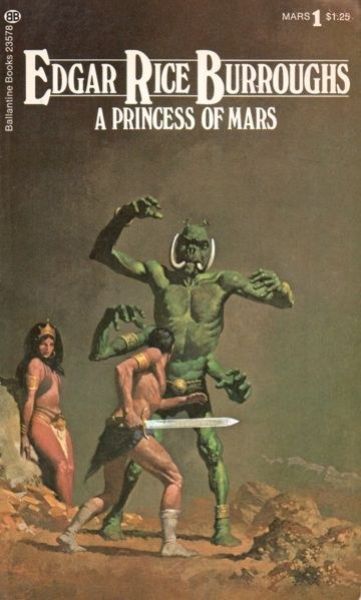Spare Me Over
A Princess of Mars (Barsoom, volume 1)
By Edgar Rice Burroughs

9 Dec, 2018
1912’s A Princess of Mars is the first book in Edgar Rice Burroughs’ interminable Barsoom series.
Having fought on the losing side of the Slavers’ Uprising, Captain John Carter heads west to see what he can steal from North America’s indigenous population. Cornered by a Native American warband, death seems inevitable … but as is the way of portal series, Carter finds himself transported to an entirely unfamiliar world.
Carter is on dying Mars, or as its inhabitants call it, Barsoom.
Wandering across Barsoom’s desolate expanse, Carter encounters and is adopted by a band of Tharks, green-skinned, six-limbed barbarians. Although not inclined towards charity or other soft sentiments, the Tharks value combat prowess. Not only is Carter an hardened veteran, his muscles are adapted to gravity many times that of Barsoom. Despite being much smaller than the Tharks, he can more than hold his own.
Carter discovers other Barsoomians far more like humans in appearance when the Tharks attack a scientific mission unfortunate enough to cross their path. Dejah Thoris, princess of the city state of Helium, is not just humanoid: she’s beautiful. Carter falls in love with her on first sight. Alas, her demise seems imminent. The Tharks plan to torture her to death. This is some sort of a message to her people. “Stay away!” or perhaps “Tharks are terrible neighbours.”
Nothing for it but to rescue the Princess and escape from the savage (although honourable) Tharks. Alas for Carter, he and the Princess are soon separated. While he survives every near-death experience that follows, by the time he encounters the Princess again, she has been blackmailed into impending marriage to another man!
The obvious solution (for Carter) is to kill the presuming fellow. However, Barsoomian culture forbids marrying the murderer of one’s fiancé or husband. Of course, Dejah Thoris could do the deed, but the fiancé’s family (or rather, the army they control) would then sack Helium.
There’s a third way out. When you cannot kill someone yourself, orchestrate a barbarian invasion to level their city in the hope that one of the many thousands of casualties will be your enemy!
~oOo~
To be honest, I thought the Barsoom books were mostly crap even when I was a teen. But I read them. SF was hard to come by. Many authors benefited from my habit of reading voraciously regardless of quality.
I had remembered that Carter fought on the side of pure evil in the Slavers’ Uprising. What I forgot was the framing sequence in which Burroughs, writing as Burroughs, asserts that Carter is a such a fine chap that
We all loved him, and our slaves fairly worshipped the ground he trod.
What makes that passage eye-opening is that ERB was born in Chicago in 1875, twelve years after the Emancipation Proclamation. What a remarkable family the Burroughs must have been! Imagine maintaining a population of slaves a decade and more after Emancipation!
Burroughs’ Mars is based on his era’s popular understanding of Mars: a once-great world slowly being choked to death as water and air vanish1. The place is one serious industrial mishap from total extinction (which figures into a few Barsoom plots). But the dying world trope explains all the hidden and lost cities the protagonists keep discovering, as well as the desperate conflicts for resources that occupy the survivors.
Burroughs’ biology is also outré. Carter and Dejah Thoris have a child. That is, Dejah lays an egg which hatches a kid. Now, the odds of an egg-laying humanoid being inter-fertile with a terrestrial human should be slim but … handwaving. Or it’s possible that Carter is not the father of Dejah Thoris’ egg or that Carter is not human. I could argue for either possibility, based on a few passages in the book. But the likeliest answer is hand-waving based on biological ignorance.
Carter is a man’s man in early 20th century style. As long as nobody gets between Carter and what he wants, he’s an easy-going fellow, as comfortable living with warrior nomads as with civilized people. He’s also ready to kill you off if you get in his way, whether you’re a nomad or an urbanite. Best to keep on his good side. Not my kind of guy, but your mileage may vary. Mileage did vary, one hundred years ago.
The plot is repetitive and contrived; the frame story is utterly implausible. But the books were mega-best-sellers. That may have been due in part to the titillation factor; Barsoomians don’t wear much in the way of clothing, a trope which survives to this day as chicks-in-chainmail-bikinis. IMHO, it was in greater part due to ERB’s mastery of a breakneck narrative pace. Most of the book (frame story aside) is a page-turner.
The Barsoom books helped shape the worlds of SF, fantasy, and comics2. Semi-nude characters in comics and on covers3, dying worlds, portal fantasies. It’s part of our genre DNA. You should read at least one, if only to assure yourself you could do better.
A Princess of Mars is available on Project Gutenberg.
1: The picture of Mars as dying world of canals is based on the work of Percival Lowell, who wrote several books recounting his astronomical researches. Or rather, his astronomical fantasies. Other astronomers of the time were doubtful … and rightly so. Lowell’s canals seem to be a result of pareidolia: seeing patterns in random data.
2: I was struck, while reading this book, by the parallels between Carter and Superman. Like Carter, Superman is strong because he comes from a high gravity world. Like Barsoom, Superman’s birth world borrows place-names from the noble gases. I suspect the parallels are not accidental.
3: Although the original book cover featured demurely concealed figures:

